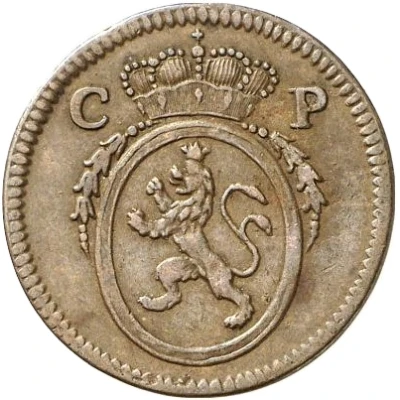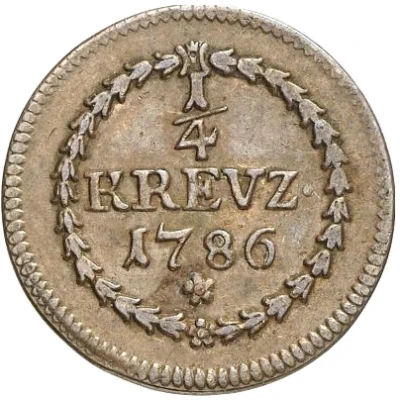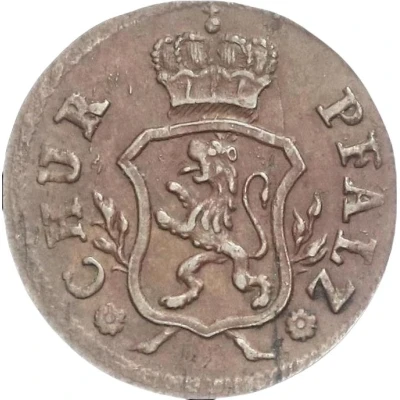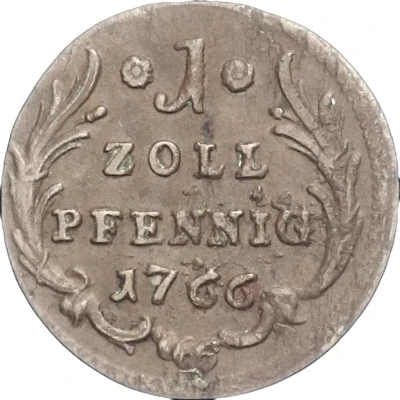


© Heidelberger Münzhandlung Herbert Grün e.K.
¼ Kreuzer - Charles Theodor
| Copper | 4.02 g | 23 mm |
| Issuer | Electors of the Palatinate (Palatinate, German States) |
|---|---|
| Elector palatine | Charles IV Theodore (Karl IV Theodor) (1742-1777) |
| Type | Standard circulation coin |
| Years | 1773-1795 |
| Value | ¼ Kreuzer (1⁄480) |
| Currency | Thaler |
| Composition | Copper |
| Weight | 4.02 g |
| Diameter | 23 mm |
| Thickness | 1 mm |
| Shape | Round |
| Orientation | Medal alignment ↑↑ |
| Demonetized | Yes |
| Updated | 2024-10-05 |
| Numista | N#17289 |
|---|---|
| Rarity index | 46% |
Reverse
Value within wreath
Script: Latin
Lettering:
1/4
KREVZ ·
1786
Comment
The County Palatine of the Rhine (German: Pfalzgrafschaft bei Rhein), later the Electorate of the Palatinate (German: Kurfürstentum von der Pfalz) or simply Electoral Palatinate[3] (German: Kurpfalz), was a territory in the Holy Roman Empire (specifically, a palatinate) administered by the Count Palatine of the Rhine. Its rulers served as prince-electors (Kurfürsten) from time immemorial, were noted as such in a papal letter of 1261, and were confirmed as electors by the Golden Bull of 1356.The fragmented territory stretched from the left bank of the Upper Rhine, from the Hunsrück mountain range in what is today the Palatinate region in the German federal state of Rhineland-Palatinate and the adjacent parts of the French regions of Alsace and Lorraine (bailiwick of Seltz from 1418 to 1766) to the opposite territory on the east bank of the Rhine in present-day Hesse and Baden-Württemberg up to the Odenwald range and the southern Kraichgau region, containing the capital cities of Heidelberg and Mannheim.
The Counts Palatine of the Rhine held the office of imperial vicars in the territories under Frankish law (in Franconia, Swabia and the Rhineland) and ranked among the most significant secular Princes of the Holy Roman Empire. In 1541 elector Otto Henry converted to Lutheranism. Their climax and decline is marked by the rule of Elector Palatine Frederick V, whose coronation as King of Bohemia in 1619 sparked the Thirty Years' War. After the 1648 Peace of Westphalia, the ravaged lands were further afflicted by the "Reunion" campaigns launched by King Louis XIV of France, culminating in the Nine Years' War (1688–97). Ruled in personal union with the Electorate of Bavaria from 1777, the Electoral Palatinate was finally disestablished with the German mediatization in 1803
Interesting fact
One interesting fact about this coin is that it was minted during the reign of Charles Theodor, who was the last Elector of the Palatinate before it was annexed by Bavaria in 1795.
Price
| Date | Mintage | VG | F | VF | XF | AU | UNC |
|---|---|---|---|---|---|---|---|
| 1775 | - | - | - | - | - | - |
Values in the table are based on evaluations by sales realized on Internet platforms. They serve as an indication only for ¼ Kreuzer - Charles Theodor 1773-1795 coin.

